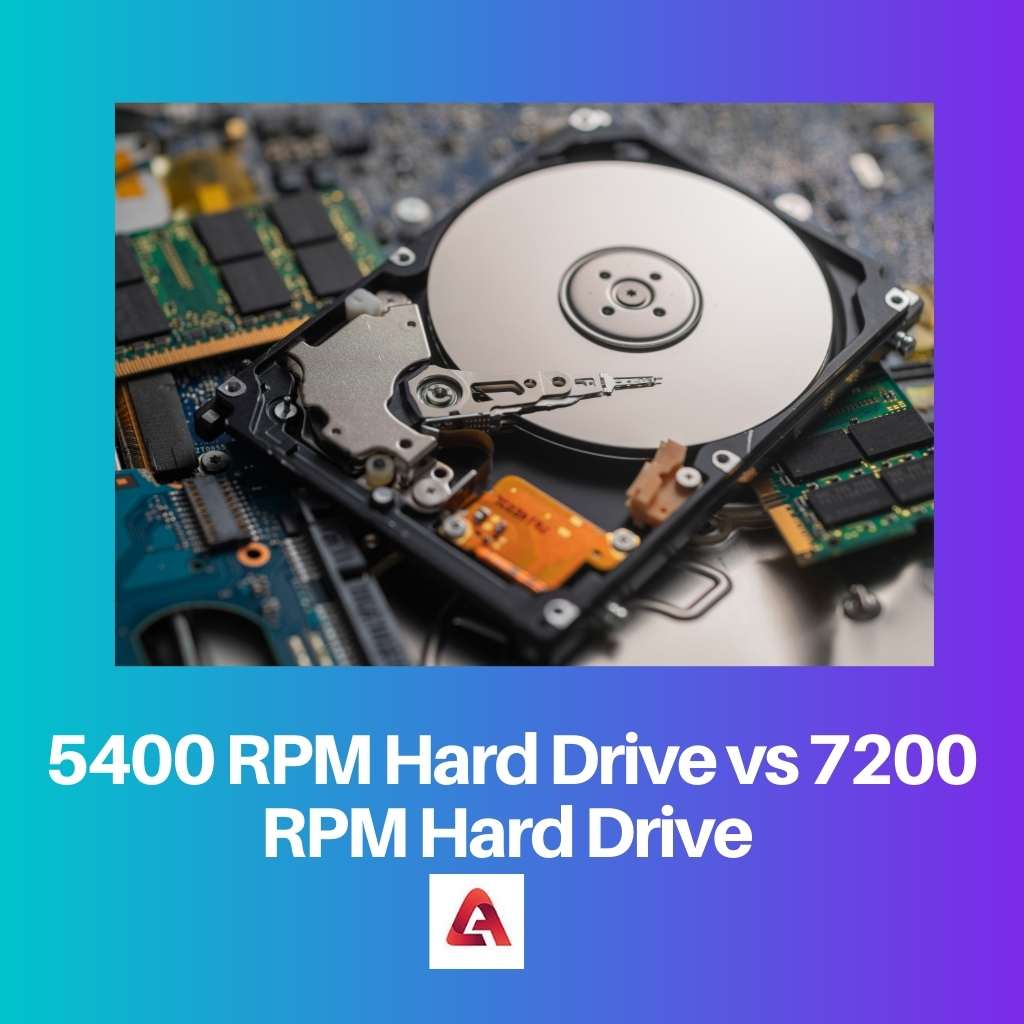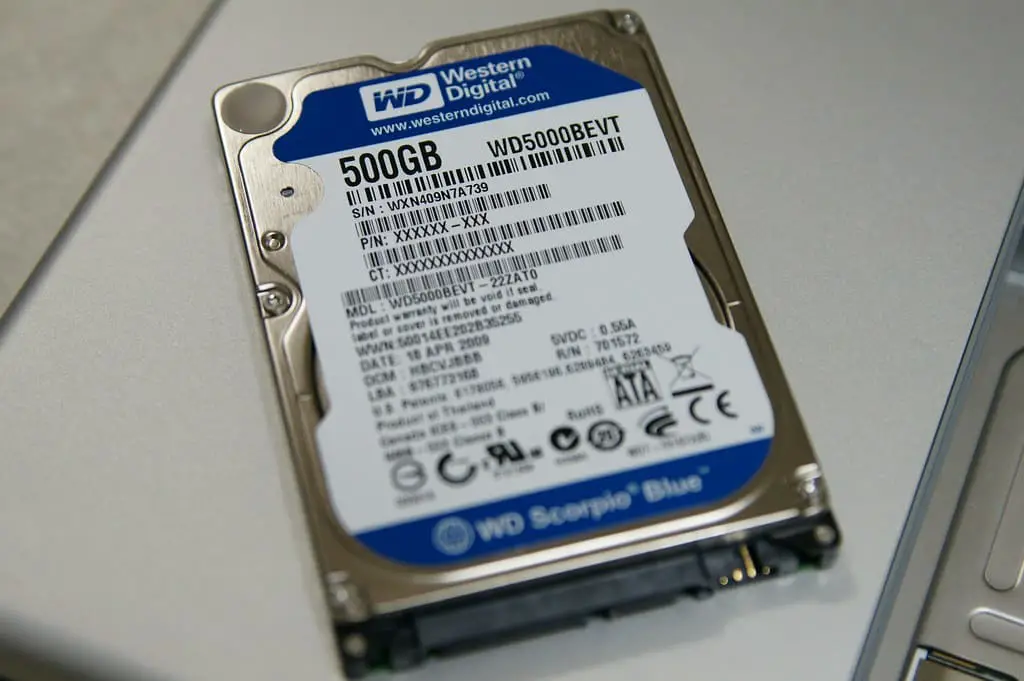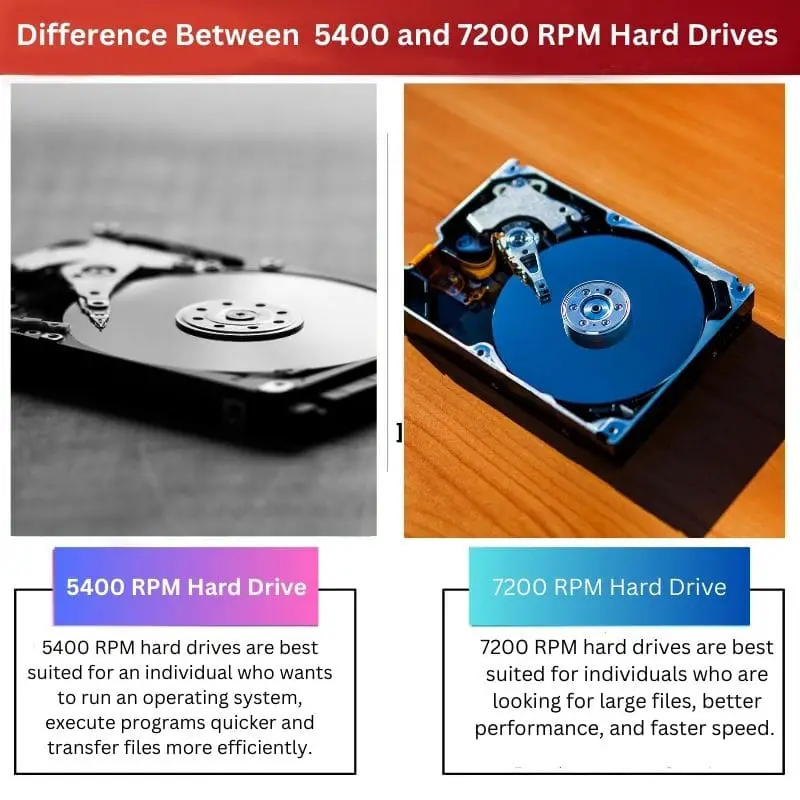While most people will dismiss hard drives, they are a viable option for storing massive information. Although hard drives may now spin up to 15000 RPM, the most common drives for desktops and laptops are between 5400 and 7200 RPM.
Key Takeaways
- 7200 RPM hard drives have faster read/write speeds than 5400 RPM drives.
- 5400 RPM hard drives consume less power and generate less heat than 7200 RPM drives.
- 7200 RPM hard drives are better for performance-intensive tasks; 5400 RPM drives are suited for energy-conscious users.
5400 RPM Hard Drive vs 7200 RPM Hard Drive
A 7200 RPM hard drive spins its platters 50% faster than a 5400 RPM drive, which means it can read and write data faster. This makes 7200 RPM drives better suited for tasks requiring high-speed data transfer. 5400 RPM drives are slower and may be more suitable for basic computer use.

5400 RPM are hard drives that offer a slower file transfer speed. However, they use less power which also means that they use less heat and provide a quieter operation.
They are also more affordable. 5400 RPM drives are recommended if you intend to have to work on a low-power server.
7200 RPM hard drives allow your operating systems or programs to function faster and in a more efficient manner. So, it’s more suitable for you if you wish to run applications of HDDs or install an operating system.
The advantage of 7200 RPM hard discs is their great performance. 7200 RPM hard drives tend to outperform 5400 RPM hard drives.
Comparison Table
| Parameters of Comparison | 5400 RPM Hard Drive | 7200 RPM Hard Drive |
|---|---|---|
| Suitable For | To run an operating system, execute programs quicker, and transfer files. | Storing large files, better performance. |
| Read and Write Speeds | 100 MB/s | 120 MB/s |
| Cost | Less expensive | More expensive |
| Speed | Slower | About 20 to 33% faster. |
| Power Consumption | Less | More |
| Heat | Creates less heat | Creates more heat. |
| Advantage | Longer lifespan, low noise, etc. | High performance |
What is 5400 RPM Hard Drive?
A hard drive with an average spin of 5400 RPM is best suited for needs to running an operating system, executing programs quicker, transferring files, etc.
Higher rotation speed on a hard drive can reduce average rotation delay and true read and write time,
but it also has drawbacks which can be seen in the form of increased temperature, increased motor spindle wear, increased operation noise, and so on.
One of the biggest advantages of a 5400 RPM hard drive is that it is comparatively more affordable, which means it’s very popular among students and beginners.
However, it can be unpopular among professionals because its speed is slower, with an average read and write speed of 100 MB/s.
Reduced energy consumption, little heat output, low noise, and a longer lifespan are all advantages of 5400 RPM hard drives. Higher rotation speed on a hard drive can reduce average rotation delay and true read and write time.
Third-generation SSHD technology is built on a 5,400 RPM HDD platform and outperforms the previous generation product, which was built on a 7,200 RPM HDD platform.
Notebooks employ 5400 RPM hard drives due to heat dissipation and portability requirements.
If all other conditions remain constant, the battery’s operating time will be reduced. It is seen as a viable choice for storing huge files.

What is 7200 RPM Hard Drive?
Historically, 7200 RPM hard drives offer fast read and write rates and are better suited to running an operating system, executing applications quickly, and transferring files.
7200 RPM hard drives have certain drawbacks. The main one that affects a person’s decision is that they are more expensive.
Some other factors are that they require more power, produce more heat, are noisier, etc. Their lifespan is also, on average, shorter than the hard drives with a lower RPM.
A 7,200 RPM drive will transmit data approximately 20% to 33% faster than a 5,400 RPM drive. As a result, this parameter is critical when determining the projected performance of a hard disc or comparing different HDD models.
In addition, 7200 rpm hard drives produce greater noise than 5400 rpm hard drives. If you only have one or two hard discs, this may not be a significant concern.
However, if you have a number of things operating at the same time, the cumulative noise can be rather annoying.
This, coupled with lower power consumption, is one of the reasons why some servers prefer 5400 rpm hard drives over 7200 rpm hard drives.
The rotation speed is faster than that of hard discs with 5400 RPM rotation speeds. The read and write speed of 7200 RPM is an average of 120 MB/s, whereas the speed of 5400 RPM is 100 MB/s.

Main Differences Between 5400 and 7200 RPM Hard Drives
- 5400 RPM hard drives are best suited for an individual who wants to run an operating system, execute programs quicker and transfer files more efficiently. On the other hand, 7200 RPM hard drives are best suited for individuals who are looking for large files, better performance, and faster speed.
- The average read and write speed of 5400 RPM is 100 MB/s, whereas the average read and write speed of 7200 RPM is 120 MB/s.
- 7200 RPM is more expensive, while 5400 RPM hard drives tend to be more affordable.
- The overall speed of a 5400 RPM hard drive is slower in comparison to a 7200 RPM hard drive that tends to be about 20% to 33% faster approximately.
- The power consumption of a 7200 RPM hard drive is comparatively more than a 5400 RPM hard drive.
- A 5400 RPM produces a lesser amount of heat in comparison to 7200 RPM.
- Some advantages of 5400 RPM include a longer lifespan, low noise, etc. Some advantages of 7200 RPM are its high performance.

I was already familiar with the differences, but a great overview for those who are not. Well-written and easy to understand.
Wow, I had no idea of the differences between these hard drives! If I were looking for high-speed data transfer, a 7200 RPM drive would definitely be worth the investment.
Not sure if the difference is large enough to pay extra for a 7200 RPM hard drive though.
That is very interesting. I didn’t know there was such a difference between hard drives. This makes a great case for getting a 7200 RPM hard drive for my computer. Thank you!
Good point, Julia63. It’s always good to check these specs when buying a computer.
Yes, the price doesn’t seem to outweigh the benefits.
Using a 7200 RPM hard disk drive can improve the performance of your operating system, which is the best choice for me. Thanks for these clear explanations about the differences between both devices.
I prefer to save money and go for the cheaper option.
While it’s great to understand the differences, I’m not sure that it makes that much of a difference in day-to-day use.
This was very informative. It’s definitely something to consider when shopping for a hard drive.